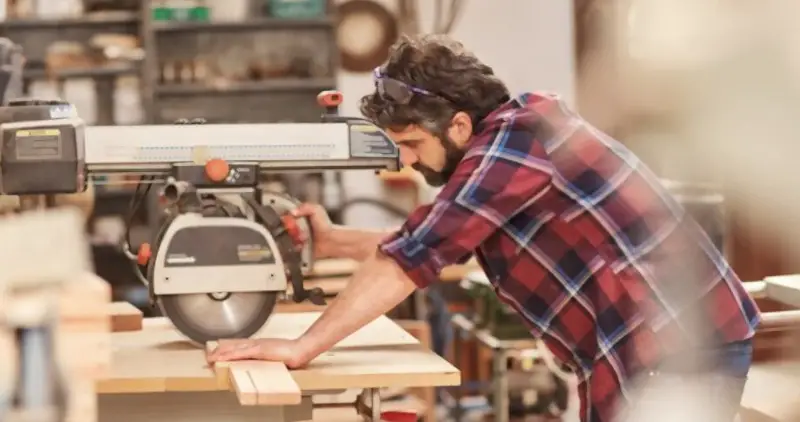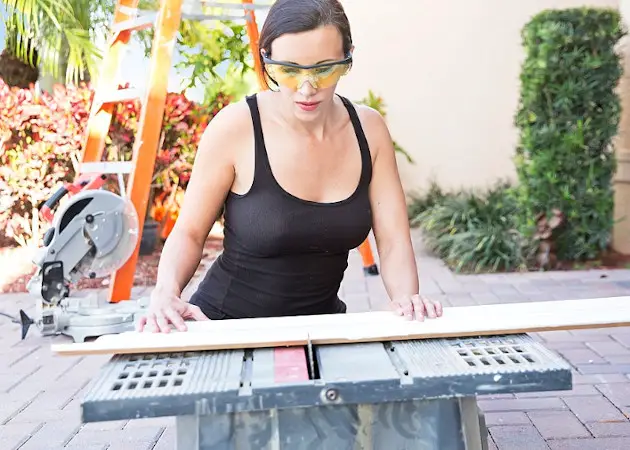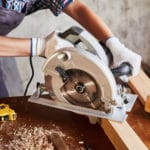The radial arm saw and the table saw are both excellent tools to have in your workshop. Both of them will get the job done, but they each work best for different tasks. If you’re not sure which one is right for you, here’s a quick rundown that should help make your decision easier!
What is a Radial Arm Saw?

A radial arm saw is a powerful, versatile machine. It has the ability to tilt and pivot allowing for precise effortless bevel and miter cuts in four directions.
A radial arm saw is a tool that’s meant for crafting projects where accuracy is key. It’s great for making bevels and cutting angles on tabletops, and it can also be used to shape up joints between two pieces of wood.
It can’t be used to rip boards, since the radial blade will cause problems with the material as it moves down the board when being ripped. It also has a smaller capacity, meaning you’ll have to make more passes than you would on a table saw.
It’s important to note that radial arm saws can be dangerous, so it’s best not to use one if you’re inexperienced.
Radial Arm Saw Safety Tips
Radial arm saws are a risky piece of equipment to operate because of the potential for injury that they pose. Fortunately, there are some steps that can be taken in order to lessen this risk. The user manual is absolutely crucial and should not be ignored as it will provide all necessary information on how to use the machine safely and what safety precautions need to be taken.
It’s very important to take all precautions before using the radial arm saw because it’s easy for someone to get injured – even if they are just in the area of the perimeter of the blade.
The areas where there are most dangers are near the exposed blades and around the rotating parts. You should also be aware of low-hanging cords and flying debris while operating the machine.
What is a Table Saw?

The table saw excels at making rip cuts or crosscuts through sheets of material such as wood or drywall with ease because it incorporates a blade guard system that helps to prevent kickback, a spinning blade that could cause injury.
The table saw gets its name from the fact that it sits on top of a table. It will work for almost all tasks in your workshop – ripping boards, cutting angles, and making joints are just some examples! The safety features make this tool ideal for beginners as well as experts.
This type of power tool has more blades than radial saws do, which means there’ll be less friction and snagging with your material while you cut through it. This gives you much better accuracy when working with intricate cuts or shapes. They also have an adjustable fence, meaning you won’t have to measure every time and can just line up the fence with your desired point.
Table saws are also great for ripping boards, so if that’s something you need a power tool for from time to time then it might be best for you!
Table Saw Safety Tips
Table saw use is considered unsafe because when the blade’s spinning. A person can get caught in the line of fire. For this reason, safety glasses or goggles that provide eye protection should be used.
When cutting thicker materials, use the correct blade and put on the appropriate guard for the material being cut.
Do not do any work with your hands or feet near the blade or throat opening. Keep your body away from both so you won’t be at risk of getting caught in their path if they start moving unexpectedly.
Stay on one side of the blade whenever possible. Using both sides can lead to dangerous kickbacks – even if you’re only using one hand and following all safety precautions.
Comparison of the Radial Arm Saw and the Table Saw
Radial Arm Saw
- Radial arm saws offer the advantage of versatility and precision in beveling and mitering. The radial arm saw allows you to work perpendicular to the blade unlike a table saw which typically only cuts in one direction. This means that radial arm saws are able to make bevel and miter cuts at any desired angle without the need for a cutting jig.
- A radial arm saw allows you to get into tighter corners than a table saw where there might not be room to position your material.
- A radial arm saw has the ability to pivot at any angle while allowing you to simultaneously tilt it up or down.
- Save space with radial arm saws since they can be easily wheeled out of the way when not in use.
- The radial arm saw can cut wider boards because it moves in a radial fashion while cutting boards.
Table Saw
- A table saw has a blade with radial teeth that allow the machine to cut in any direction without having to change blades or jigs, and they come with a stronger more powerful system that can cut through thick material without you needing to increase the cutting speed.
- A table saw has the ability to tilt and pivot, making it possible for precise cuts in either direction.
- A table saw is a more stationary machine, which can be limiting when radial arm style cuts are needed.
Which Tool Should You Buy?
If you’re looking for a versatile tool to handle different types of projects then you should buy the radial arm saw. It’s perfect for most woodworking tasks and relatively easy to use. The radial arm saw is also a great choice if space in your workshop or garage is limited.
If you need to make intricate cuts, then the table saw would be best for you because it’s more stationary and can easily handle more delicate work. If radial style cutting isn’t necessary, then the radial arm saw might not be right for you!
Conclusion
The radial arm saw and table saw are both saws that can handle large pieces of wood. However, the table saw is more versatile because it has a table to cut on as well as being able to be mounted in different ways for use with other materials.
This means you won’t have to buy additional tools if your needs change from cutting straight lines to curved ones or even circular cuts. If you want something portable and easy-to-use, then the radial arm saw might be best for you!





